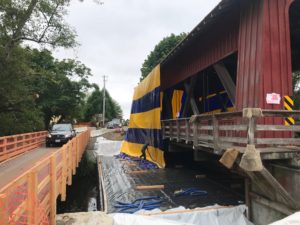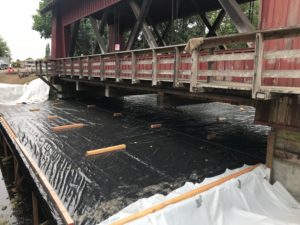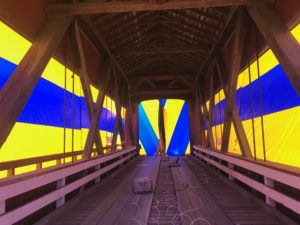Looking for Access?
Cur nutrix cantare?Est camerarius accentor, cesaris.Eposs sunt solems de varius liberi.
Register TodayCur nutrix cantare?Est camerarius accentor, cesaris.Eposs sunt solems de varius liberi.
Register TodayCur nutrix cantare?Est camerarius accentor, cesaris.Eposs sunt solems de varius liberi.
Login Now
Imagine some people driving by a tented structure, smiling and giving the fumigation crew an enthusiastic thumbs-up sign, especially in an area where residents are known for being environmentally sensitive.
Big Time Pest Control and Your Way fumigation got to play public hero by fumigating a covered bridge that happens to be a local treasure near Bayside, California. Spanning 66 feet across Jacoby Creek, the Brookwood bridge serves as the sole access for about 25 homeowners living on the south side of Jacoby Creek in Humboldt County, California. It’s a remote national forest area, and this single-span bridge provides a majestic view that has made it a favorite background for wedding photos.
Unfortunately, wood-boring beetle damage was discovered several years ago. For the Humboldt County Department of Public Works, one option was to replace the bridge with a modern concrete or steel structure. The other option was to rehabilitate the bridge — the approach universally favored by locals who wanted to preserve their landmark.
In March 2015, Big Time Pest Control in Anderson, California, was called in to inspect the bridge and make a recommendation.
“Anobiid beetles are a problem in the area because of the high humidity, says Mike Bullert, president of Big Time. “The bridge was determined by engineers to be structurally sound, but damage had reached the point where you could put your thumb through some openings in some support beams. Damage was heaviest in the lower portion of the bridge closer to the creek.”
Several factors made the bridge challenging:
The two fundamental challenges were how to conduct an effective fumigation and gaining state approvals for the fumigation plan.
“This was a nontypical project, so we sought a lot of expert opinions on how to fumigate to get results while protecting the environment,” Bullert says. “Doug Belle and Pam Johnson with Douglas Products worked with us. We also talked about it to other fumigators at Pest Control Operators of California meetings. Vernard Lewis, Ph.D. now a consultant after retiring from the University of California – Riverside, helped us run a virtual fumigation.”
Fumigation was just one aspect for the county to consider. Rehabilitation of the bridge also required replacing a deteriorated pedestrian walkway, an existing traffic railing to meet current safety standards, an untreated portion of the existing bridge deck system and some of the roofing. In addition, the exterior of the covered timber housing structure needed to be painted.

To make it possible to wrap the bridge, county employees constructed a platform beneath the bridge but above the creek. Your Way Fumigation placed sand snakes on top of a custom platform to seal the tarps. At left is a one-lane bridge constructed by the county for local traffic.
To allow traffic over the bridge during the fumigation, one proposal was to tarp the bridge to create a functional tunnel inside for traffic. However, this was deemed to be too risky, so instead, the county cut down some trees near the bridge and constructed a temporary bypass bridge.
Additional approvals involved work with the California Department of Pesticide Regulation and the county ag department to ensure public safety and environmental protection.
The fumigation was started on Wednesday, Aug. 1 and completed on Saturday, Aug. 4. On hand were Big Time Pest Control, Your Way Fumigation, Cardinal Distribution, California DPR, county ag department, the county department of public works and their engineer consultants. A professional security company stayed on-site during the fumigation process.

The bridge prior to tarping with the platform constructed above the creek but below the bridge to give the fumigation crew space to work
Logistically, the fumigation required a 4½-hour drive to the site for Big Time Pest Control, a 6-hour drive for Cardinal Distribution to deliver the cylinders of Vikane® gas fumigant and a 6-hour drive from Your Way Fumigation’s branch office in Sacramento, California.
Efficacy was ensured by monitoring with an RDA over a 72-hour exposure. Following the fumigation, a topical application with BoraCare to the wood members was made to provide residual protection.
In addition to saving their landmark, homeowners were happy with the fumigation thanks to a town hall meeting in 2016 to present the fumigation plan. In that meeting, regulatory officials and engineers discussed the bridge damage and needed repairs. Big Time Pest Control talked about the pest and how the fumigation would eliminate the problem.

To monitor the fumigation over the 72-hour exposure, an RDA was used.
“This was a fun community event because of how much they cared about the bridge,” Bullert says. “The bridge is part of the landscape and fabric of that community. When we started to tarp the day before the fumigation, a lady walked up with a young woman in a bride’s dress behind her. They wanted to take photos. Later, another guy showed up in a Hawaiian shirt. His hobby was photographing covered bridges and he had driven almost 10 hours to get there. This bridge was on his bucket list.
“One lady also came to check out our work every day. It turns out that the bridge had been built in 1967 by a university engineering professor. He died last year before the restoration began. The lady was his widow. She had a big smile on her face as we prepared it for the fumigation.”
How do you fumigate a covered bridge?
According to plan, says Alex Luna, general manager with Your Way Fumigation in Sacramento, California.
Actually, with a slight change from plan, he adds. When the three-person fumigation crew arrived at the job site on Tuesday afternoon, they decided to tarp the bridge that evening instead of the next morning as scheduled. One reason was a concern about possible showers that night. And it did rain, but because the bridge was already prepared, the fumigation stayed on schedule.
To make work access easier for the fumigation crew, the county had built a custom platform beneath the bridge.
“The creek is 60 feet wide, but only 4 or 6 inches deep this time of year,” Luna says. “Thanks to the county, we were able to work about four feet above the water and close to the underside of the bridge.”
Your Way used four tarps to cover the bridge roof and sides. They used one tarp the full length of the bridge on the underside, bringing it up onto the bridge and rolling it together with the dropped tarps. Sand snakes were used inside to hold the tarps in place to form a tented cylinder, like a burrito. Spray adhesive on the concrete abutments on both ends of the bridge held the tarps in place and then they were tightly sealed with tape.
It was cool on Wednesday morning, in the mid-50s, but by midafternoon it had warmed up to the mid-60s. The fumigation was monitored with an RDA Fumiscope to ensure a lethal dose.
“We had a tight seal and did not need to use more Vikane than had been planned,” Luna says. “We had a detailed fumigation plan in place and everything went according to plan.”
®Vikane is a federally Restricted Use Pesticide